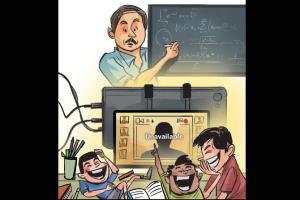Post lockdown we have seen many videos of online classes gone wrong. Some were benign, pure comedy of Zoom confusion

Illustration/Uday Mohite
![]() Last week, a fictional story about a teacher struggling to cope with online classes went viral. The writer, Ajoi Rajbanshi, developed an idea by Syed Mohammed Fahim and posted it on Facebook. A 55-year-old teacher, instructed by the principal to teach on Zoom, struggles financially as well as culturally to use this new medium. Capitalising on his uncertainty, students prank him, muting his audio, abusing him and disrupting the class. Humiliated, he breaks down, and is comforted by his young daughter. There is sentimentality and pathos in the storytelling and a lot of truth as well.
Last week, a fictional story about a teacher struggling to cope with online classes went viral. The writer, Ajoi Rajbanshi, developed an idea by Syed Mohammed Fahim and posted it on Facebook. A 55-year-old teacher, instructed by the principal to teach on Zoom, struggles financially as well as culturally to use this new medium. Capitalising on his uncertainty, students prank him, muting his audio, abusing him and disrupting the class. Humiliated, he breaks down, and is comforted by his young daughter. There is sentimentality and pathos in the storytelling and a lot of truth as well.
ADVERTISEMENT
Post lockdown we have seen many videos of online classes gone wrong. Some were benign, pure comedy of Zoom confusion. Now, the genre has begun to harden: students mocking teachers, locking them out of the class, making rude comments about their personal lives. Sometimes these "online roast of teacher" videos are enacted, not with an aim to critique the violence of students, but take pleasure in the humiliation of teachers. Popular comics do sketches or compile such videos, adding laugh tracks and commentary, about how you have to be a severe boomer if you wear your headphones thus, or place your device wrongly. People who once made fun of people's inability to speak cool English, now mock their lack of fluency with technology. Framed as challenging age or authority figures, the underlying arrogance of class and caste vibrates at high voltage, but, theek hai, intersectionality is an English word, so I guess you don't need to apply it to people who speak other languages, hai na?
It's a truism that the pandemic has revealed the frayed seams of many social institutions. Whether it is elites not paying their domestic staff, the misery and poverty of the medical system or the educational system.
India has over 250 million students enrolled in schools of which over 65 per cent go to government schools. The exodus towards private schools is slow but steady, owing to the terrible infrastructure and high student-teacher ratio in government schools, with a few notable exceptions. Not everyone who goes to a private school is automatically well-off. Many poor families invest in their children's education by sending them to private schools. Meanwhile, the average annual salary of an Indian teacher is R2 lakh (although, obviously higher in private schools). Just under 11 lakh teachers are contract workers. Many have not received their salaries in these past months. They don't always have access to laptops or the skills training for digital education. They are meant to make it all work through some magical exertion of authority and overtime. A system with abusive potential.
Digital education assumes all students can actually access digital classrooms. Most students live in homes with one phone—not always a smartphone, not always accessible. Internet access in their homes is limited, like so many other resources. We always speak of technology like it is a magic wand, in a cascade of catch-phrases and glib hash-tags. The seemingly useful term, digital divide, somehow sounds so technical, like it can be fixed with a little effort. Suggest stopping digital classes and watch middle-class parents outrage.
Below this phrase is the deep inequality that not only creates but maintains this divide. Sometimes, we even go to school to learn how to keep it.
Paromita Vohra is an award-winning Mumbai-based filmmaker, writer and curator working with fiction and non-fiction. Reach her at paromita.vohra@mid-day.com
Catch up on all the latest Mumbai news, crime news, current affairs, and a complete guide from food to things to do and events across Mumbai. Also download the new mid-day Android and iOS apps to get latest updates.
Mid-Day is now on Telegram. Click here to join our channel (@middayinfomedialtd) and stay updated with the latest news
 Subscribe today by clicking the link and stay updated with the latest news!" Click here!
Subscribe today by clicking the link and stay updated with the latest news!" Click here!






